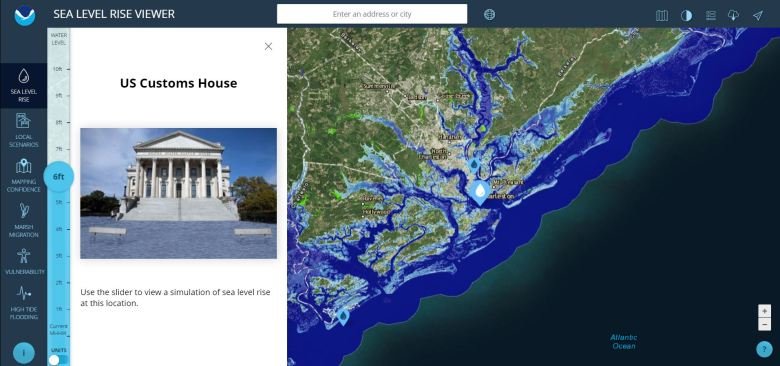Education
A government climate website teachers rely on is in peril

For the last 15 years, science teacher Jeff Grant has used information on climate change from the federal website Climate.gov to create lesson plans, prepare students for Advanced Placement tests and educate fellow teachers. Now, Grant says, he is “grabbing what [he] can” from the site run by the National Oceanic and Atmospheric Administration’s Climate Program Office, amid concerns that the Trump administration is mothballing it as part of a broader effort to undermine climate science and education.
“It’s just one more thing stifling science education,” said Grant, who teaches at Downers Grove North High School in the Chicago suburbs.
Since early May, all 10 editorial contributors to Climate.gov have lost their jobs, and the organization that produces its education resources will soon run out of money. On June 24, the site’s homepage was redirected to NOAA.gov, a change NOAA said was made to comply with an earlier executive order on “restoring gold standard science.” Those steps follow many others the president has made to dismantle federal efforts to fight climate change, which his administration refers to as the “new green scam.”
Former employees of Climate.gov and other educators say they fear that the site, which will no longer produce new content, could be transformed into a platform for disinformation.
“It will make it harder for teachers to do a good job in educating their students about climate change,” said Glenn Branch, deputy director of the nonprofit National Center for Science Education. “Previously, they could rely on the federal government to provide free, up-to-date, accurate resources on climate change that were aimed at helping educators in particular, and they won’t be able to do so if some of these more dire predictions come to pass.”
Such concerns have some foundation. For example, Covid.gov, which during the Biden administration offered health information and access to Covid-19 tests, has been revamped to promote the controversial theory that the coronavirus was created in a lab. The administration has also moved aggressively to delete from government sites other terms that are currently out of favor, such as references to transgender people that were once on the National Park Service website of the Stonewall National Memorial, honoring a major milestone in the fight for LGBTQ+ rights.
Kim Doster, director of NOAA’s office of communications, declined to answer specific questions but shared a version of the statement posted on the NOAA website when Climate.gov was transferred. “In compliance with Executive Order 14303, Restoring Gold Standard Science, NOAA is relocating all research products from Climate.gov to NOAA.gov in an effort to centralize and consolidate resources,” it says.
Related: Want to read more about how climate change is shaping education? Subscribe to our free newsletter.
Climate.gov, founded in 2010 to support earth science instruction in schools, had become a go-to site for educators and the general public for news and information about temperature, sea level rise and other indicators of global warming.
For many educators, it has served a particularly key role. Because its resources are free, they are vital in schools that lack resources and funding, teachers and experts say.
Rebecca Lindsey, Climate.gov’s lead editor and writer, was one of several hundred NOAA probationary employees fired in February, then rehired and put on administrative leave, before being terminated again in March. The rest of the content production team — which included a meteorologist, a graphic artist and data visualizers — lost their jobs in mid-May. Only the site’s two web developers still have their jobs.
Lindsey said she worries that the government “intended to keep the site up and use it to spread climate misinformation, because they were keeping the web developers and getting rid of the content team.”
In addition, the Climate Literacy and Energy Awareness Network, the official content provider for the education section of the site, has not received the latest installment of its three-year grant and expects its funds to run out in August.
“We won’t have funding to provide updates, fix hyperlinks and make sure that new resources are being added, or help teachers manage or address or use the resources,” said Anne Gold, CLEAN’s principal investigator. “It’s going to start deteriorating in quality.”
CLEAN, whose website is hosted by Carleton College, is now searching for other sources of money to continue its work, Gold said.
With the June 24 change redirecting visitors from Climate.gov to NOAA.gov/climate, the website for the first time falls under the purview of a political appointee: Doster. Its previous leader, David Herring, is a science writer and educator.
Melissa Lau, an AP environmental science teacher in Piedmont, Oklahoma, said the relocated site was “really difficult to navigate.”
As someone who lives in Tornado Alley, Lau said, she frequented CLEAN and NOAA sites to show her students localized, real-time data on storm seasons. She said she is concerned that teachers won’t have time to track down information that was shifted in the website’s move and, as a result, may opt not to teach climate change.
The executive order on “restoring gold standard science” that appears to have triggered the shift gives political appointees the authority to decide what science information needs to be modified to align with its tenets.
While the disclaimer posted to NOAA.gov seems to imply that Climate.gov did not meet this requirement, educators and researchers said that the site and its CLEAN education resources were the epitome of a gold standard.
“I want to stress that the reason why CLEAN is considered the gold standard is because we have such high standards for scientific accuracy, classroom readiness and maintenance,” Gold said. “We all know that knowledge is power, and power gives hope. … [Losing funding] is going to be a huge loss to classrooms and to students and the next generation.”
Related: One state mandates teaching climate change in almost all subjects — even PE
This is only the latest attack by the Trump administration on education around climate change. This month, the U.S. Global Change Research Program’s website, GlobalChange.gov, was shut down by the administration, after the program was defunded in April. The website once hosted an extensive climate literacy guide, along with all five iterations of the National Climate Assessment — a congressionally required report that informed the public about the effects and risks of climate change, along with local, actionable responses.
The Department of Commerce, which oversees NOAA, has cut other federal funding for climate research, including at Princeton University, arguing that these climate grant awards promoted “exaggerated and implausible climate threats, contributing to a phenomenon known as ‘climate anxiety,’ which has increased significantly among America’s youth.”
Studies, though, suggest that if young people have a greater understanding of why weather is changing and how to take action, they are less likely to feel anxious.
“The more you know [about climate change], the more it’s not a scary monster in the closet,” said Lauren Madden, professor of elementary science education at the College of New Jersey. “It’s a thing you can react to.” She added, “We’re going to have more storms, we’re going to have more fires, we’re going to have more droughts. There are things we can do to help slow this. … I think that quells anxiety, that doesn’t spark it.”
And climate education has broad public support — about 3 in 4 registered voters say schools should teach children about global warming, according to a 2024 report from the Yale Program on Climate Change Communication. Similarly, 77 percent of Americans regard it as very or somewhat important for elementary and secondary school students to learn about climate change, according to a 2019 study. And all but five states have adopted science standards that incorporate at least some instruction on climate change.
Yet few teachers have received training on climate change. There is also not much professional development for climate educators, and textbooks tend to downplay the effects of climate change.
As a result, many science teachers rely on federal tools and embed them in their curriculum. They are worried that the information will no longer be relevant, or disappear entirely, according to Lori Henrickson, former climate integration specialist for Washington state’s education department. Henrickson, who lost her job this June as the result of state budget cuts, was in charge of integrating climate education across content areas in the state, from language arts to physical education.
The .gov top-level domain connotes credibility and accessibility, according to Branch: “It is also easier for teachers facing or fearing climate change denial backlash to cite a reliable, free source from the federal government.”
Related: How Trump is disrupting efforts by schools and colleges to combat climate change
With Climate.gov’s future uncertain, educators are looking to other resources, like university websites and tools from other countries.
“I’m sure there will continue to be tools, and there will be enough people who will be willing to pay to access them,” Madden said. But, she added, “they probably won’t be as comprehensive, and it won’t feel like it’s a democratic process. It’ll feel like: If you or your employer are willing to chip in for it, then you’ll have access.”
Madden, along with many other educators, frequently used the Environmental Protection Agency’s environmental justice toolkit, but the site was taken down earlier this year.
“I feel like with all the federal websites, I’m constantly checking to see what’s still up and what’s not,” Madden said.
Bertha Vazquez, education director for the Center of Inquiry, an organization that works to preserve science and critical thinking, said she worried that the disappearance of climate information could leave U.S. students behind.
“The future of the American economy is not in oil, the future of the American economy is in solar and wind and geothermal. And if we’re going to keep up with the international economy, we need to go in that direction,” she said. But while the U.S. should be leading the way in scientific discovery, Vazquez said, such work will now be left to other countries.
Lau said she felt helpless and frustrated about Climate.gov’s shutdown and about the “attack on American science in general.”
“I don’t know what to do. I can contact my legislators, but my legislators from my state are not going to be really open to my concerns,” she said. “If students next year are asking me questions about [science research and funding], I have to tell them, ‘I do not know,’ and just have to leave it at that.”
Contact editor Caroline Preston at 212-870-8965, via Signal at CarolineP.83 or on email at preston@hechingerreport.org.
This story about the government climate website was produced by The Hechinger Report, a nonprofit, independent news organization focused on inequality and innovation in education. Sign up for the Hechinger climate and education newsletter.
Education
Why Coursera, Udemy, and Pluralsight Are Key Buys in 2025

The digital education sector is undergoing a seismic shift as AI-driven personalization redefines how learners acquire skills. In 2025, Coursera, Udemy, and Pluralsight stand out as pioneers, leveraging cutting-edge artificial intelligence to tailor learning experiences, dominate enterprise training, and capitalize on a $360 billion global corporate training market [4]. Their strategic market positioning, technological innovation, and financial resilience make them compelling investments for forward-looking portfolios.
Coursera: Scaling AI-Powered Learning Through Academic and Corporate Partnerships
Coursera’s integration of multimodal AI—enabling learners to interact with images, audio, and video—has transformed passive content consumption into dynamic, adaptive experiences [1]. By partnering with top universities and enterprises, the platform offers professional certificates and degree programs that align with industry needs. For example, its AI-driven personalization engine analyzes user behavior to recommend courses in high-demand fields like data science and IT, ensuring learners stay ahead of skill gaps [1].
Financially, Coursera’s Q2 2025 results underscore its growth trajectory: revenue hit $187 million, a 10% year-over-year increase, with a revised full-year outlook of $738–$746 million [2]. The platform’s Degree programs grew by 13% YoY, reflecting strong demand for structured, AI-enhanced learning pathways [3]. Analysts project that Coursera’s focus on enterprise partnerships—such as its collaboration with IBM to train 100,000 employees in AI and cloud computing—will further solidify its market leadership [1].
Udemy: Monetizing AI-Driven Flexibility and Enterprise Adoption
Udemy’s Q2 2025 earnings reveal a strategic pivot to AI-powered personalization. The platform reported $199.9 million in revenue, with its Enterprise segment (Udemy Business) contributing $129.3 million—a 7% YoY increase [1]. For the first time since its IPO, Udemy achieved GAAP profitability in Q2 2025, driven by a 6% rise in Annual Recurring Revenue (ARR) for Udemy Business and a 95% Net Dollar Retention Rate [1].
Udemy’s AI innovations, such as AI-assisted role-play and automated assessments, are reshaping how learners engage with content. By integrating Google’s Agent2Agent Protocol and Anthropic’s Model Context Protocol, Udemy enables seamless AI collaboration, allowing instructors to design adaptive learning programs at scale [6]. The platform’s “AI Readiness” and “AI Growth” collections have become staples for enterprises seeking to upskill employees in AI literacy and application [2]. With 200,000+ paid consumer subscribers and a target of 250,000 by year-end, Udemy’s dual focus on individual and corporate markets positions it as a versatile player [2].
Pluralsight: Dominating Tech Education with AI-Centric Training
Pluralsight’s 2025 Tech Forecast highlights AI as the most in-demand skill among tech professionals, with a 167% surge in interest for tools like LangChain—a framework for building AI applications [5]. The platform’s emphasis on hands-on labs and real-world scenarios ensures learners master practical skills, such as deploying small language models (SLMs) for edge AI projects [5].
Pluralsight’s enterprise solutions are particularly compelling. By offering tailored training for cloud computing, cybersecurity, and data science, the platform addresses the urgent need for data specialists in AI projects [5]. Its 2025 forecast also notes a 30% improvement in knowledge retention through AI-driven personalization, a metric that resonates with corporate clients prioritizing ROI [2]. While specific 2025 financials are not disclosed, Pluralsight’s strong market presence in the $360 billion corporate training sector and its focus on AI-native content suggest robust growth potential [4].
Market Trends and Analyst Projections
The broader digital education market is accelerating. By 2025, 93% of businesses plan to adopt eLearning, driven by hybrid work models and AI’s ability to personalize training [2]. Analysts project that AI-powered platforms will outperform traditional models by 30% in skill acquisition efficiency [2]. For investors, this creates a clear opportunity: platforms that combine technological innovation with enterprise adoption—like Coursera, Udemy, and Pluralsight—are best positioned to capture market share.
Conclusion: A Triad of Innovation and Growth
Coursera, Udemy, and Pluralsight exemplify how AI-driven personalization is reshaping digital education. Their ability to adapt to evolving learner needs, secure enterprise contracts, and integrate AI into core offerings ensures sustainable growth. With the corporate training market expanding rapidly and AI literacy becoming a universal requirement, these platforms are not just surviving—they’re leading the charge. For investors, the case is clear: these three companies represent a trifecta of innovation, scalability, and market relevance in 2025.
Source:
[1] Digital Education – Company Evaluation Report, 2025 [https://www.globenewswire.com/news-release/2025/09/01/3142050/28124/en/Digital-Education-Company-Evaluation-Report-2025-Coursera-Udemy-and-Pluralsight-Lead-with-AI-Powered-Personalization-Diverse-Course-Portfolios-and-Enterprise-Focused-Tech-Training.html]
[2] Udemy Reports Second Quarter 2025 Results [https://www.businesswire.com/news/home/20250729032090/en/Udemy-Reports-Second-Quarter-2025-Results]
[3] Coursera vs Udemy Statistics By Market Share And Facts [https://electroiq.com/stats/coursera-vs-udemy-statistics/]
[4] Corporate Training Market Outlook Report 2025-2030 [https://finance.yahoo.com/news/corporate-training-market-outlook-report-080500710.html]
[5] Pluralsight 2025 Tech Forecast Reveals Path Forward for IT Professionals Amid Concerns About AI [https://www.prnewswire.com/news-releases/pluralsight-2025-tech-forecast-reveals-path-forward-for-it-professionals-amid-concerns-about-ai-302354948.html]
[6] How Udemy Will Lead the AI Skills Revolution: Q1 2025 [https://www.linkedin.com/pulse/how-udemy-lead-ai-skills-revolution-q1-2025-results-beyond-sarrazin-jaf4e]
Education
College president fears that federal education cuts will derail the promise of student parents, student military veterans and first-gen students

As a college president, I see the promise of higher education fulfilled every day. Many students at my institution, Whittier College, are the first in their families to attend a university. Some are parents or military veterans who have already served in the workforce and are returning to school to gain new skills, widen their perspectives and improve their job prospects.
These students are the future of our communities. We will rely on them to fill critical roles in health care, education, science, entrepreneurship and public service. They are also the students who stand to lose the most under the proposed fiscal year 2026 federal budget, and those who were already bracing for impact from the “One Big Beautiful Bill” cuts, including to the health care coverage many of them count on.
The drive with which these extraordinary students — both traditionally college-aged and older — pursue their degrees, often while juggling caregiving commitments or other responsibilities, never fails to inspire me.
Related: Interested in innovations in higher education? Subscribe to our free biweekly higher education newsletter.
We do not yet know the precise contours of the spending provisions Congress will consider once funding from a continuing resolution expires at the end of September. Yet we expect they will take their cues from the president’s proposed budget, which slashes support for students and parents and especially hammers those already struggling to improve their lives by earning a college degree, with cuts to education, health and housing that could take effect as early as October 1.
That budget would mean lowering the maximum Pell Grant award from $7,395 to $5,710, reversing a decade of progress. For the nearly half of Whittier students who received Pell Grants last year, this rollback would profoundly jeopardize their chances of finishing school.
So would the proposal to severely restrict Federal Work-Study, which supports a third of Whittier students according to our most recent internal analysis, and to eliminate the Supplemental Educational Opportunity Grant, which more than 16 percent of our student body relies upon. In addition, this budget would impose a cap on Direct PLUS Loans for Parents, which would impact roughly 60 percent of our parent borrowers. It would also do away with the Direct PLUS Loans for Graduates program.
These programs are lifelines, not just for our students but for students all across the country. They fuel social mobility and prosperity by making education a force for advancement through personal work ethic rather than a way to rack up debt.
If enacted, these proposed cuts would gut the support system that has enabled millions of low-income students to earn a college degree.
Higher education is a bridge. To cross it and achieve their full potential, students from all walks of life must have access to the support and resources colleges provide, whether through partnerships with local high schools or with professional gateway programs in engineering, accounting, business, nursing, physical therapy and more. Yet, to access these invaluable programs, they must be enrolled. How will they reach such heights if they suddenly can’t afford to advance their studies?
The harm I’ve described doesn’t stop with cuts to financial aid, loans and services. Proposed reductions also target research funding for NASA, NIH and the National Science Foundation. One frozen NASA grant has already led to the loss of paid student research fellowships at Whittier, a setback not just in dollars but in momentum for students building real-world skills, networks and résumés.
These research opportunities often enable talented first-generation students to connect their classroom learning to career pathways, opening the door to graduate school, lab technician roles and futures in STEM fields. We’ve seen how federal funding has supported student projects in everything from climate data analysis to environmental health.
Stripping away support for hands-on research undermines the federal government’s own calls for colleges like ours to better prepare students for the workforce by dismantling the very mechanisms that make such preparation possible.
It’s particularly disheartening that these changes will disproportionately hurt those students who are working the hardest to achieve their objectives, who have done everything right and have the most to lose from this lack of investment in the future.
The preservation and strengthening of Pell, Work-Study, Supplemental Educational Opportunity grants and federal loan programs is not a partisan issue. It is a moral and economic imperative for a nation that has long been proud to be a land of opportunity.
Let’s build a system for strivers that opens doors instead of slamming them shut.
Let’s recommit to higher education as a public good. Today’s students are willing to work hard to deserve our continuing belief in them.
Kristine E. Dillon is the president of Whittier College in California.
Contact the opinion editor at opinion@hechingerreport.org.
This story about education cuts was produced by The Hechinger Report, a nonprofit, independent news organization focused on inequality and innovation in education. Sign up for Hechinger’s weekly newsletter.
Education
Pupils in England from low-income families ‘bounced out’ of costlier GCSEs | Secondary schools

Secondary school pupils from low-income families are “bounced out” of studying subjects such as geography and languages because of fears about extra costs, according to a survey of children in England.
Nearly a quarter (23%) of those surveyed who were in receipt of free school meals (FSM) said the cost – or worries about the cost – prevented them from choosing certain GCSE subjects, compared with just 9% of non-FSM pupils.
Costs associated with geography field trips and modern foreign language visits make it difficult for the most disadvantaged students to pursue these subjects.
Other subjects with additional costs include music, because of instrument lessons, food and nutrition, which requires ingredients, and PE, due to the extra kit and equipment required.
Almost a third (30%) of FSM students said their families already struggle to afford the basics they need for homework, including access to technology and devices.
The survey of more than 1,000 students, which was conducted by Survation for the Child Poverty Action Group (CPAG), revealed stark differences between pupils on FSM and their non-FSM peers.
Secondary pupils on FSM are nearly twice as likely as their better-off peers to say their family’s income makes it harder for them to learn at school (15% v 8%). They are also more likely to say it is difficult to afford pens and pencils (14% v 8%).
Of those children in receipt of FSM, a third (34%) said it is difficult to afford school trips and a fifth (21%) struggle to pay for clubs, while more than a quarter (27%) said it is difficult to afford musical instruments or instrument tuition
CPAG’s head of education policy, Kate Anstey, said: “Children in struggling families are going back to school only to be bounced out of some subjects and learning by costs – cut off from opportunities just as the foundations of their futures are being laid.
“The prime minister has promised to leave ‘no stone unturned to give every child the very best start at life’ but actions are needed to match that objective. Government’s forthcoming child poverty strategy must invest in family incomes and children’s life chances – and scrapping the two-child limit must be the first action point.”
It costs parents of secondary schoolchildren a minimum of £2,275 a year to send a child to school, according to earlier CPAG research, of which £450 goes on learning materials including stationery, revision guides and calculators.
Labour’s flagship child poverty strategy was originally due to be published in the spring, but was delayed amid continuing debate about the cost implications of ending the two-child benefit cap.
The cap, which limits parents to claiming many means-tested benefits for their first two children, apart from in very limited circumstances, was introduced under the Conservatives. Experts say scrapping it would be the single most effective way of reducing child poverty.
A Department for Education spokesperson said: “We are absolutely clear that schools should make sure the cost of curriculum subjects is not a barrier to access and that materials necessary for examinations are provided to all pupils.
“More widely, we are putting pounds back in parents’ pockets by limiting the number of branded uniform items, expanding free school meals to every family on universal credit and rolling out free breakfast clubs across the country.”
-
Tools & Platforms3 weeks ago
Building Trust in Military AI Starts with Opening the Black Box – War on the Rocks
-

 Business3 days ago
Business3 days agoThe Guardian view on Trump and the Fed: independence is no substitute for accountability | Editorial
-

 Ethics & Policy1 month ago
Ethics & Policy1 month agoSDAIA Supports Saudi Arabia’s Leadership in Shaping Global AI Ethics, Policy, and Research – وكالة الأنباء السعودية
-

 Events & Conferences3 months ago
Events & Conferences3 months agoJourney to 1000 models: Scaling Instagram’s recommendation system
-

 Jobs & Careers2 months ago
Jobs & Careers2 months agoMumbai-based Perplexity Alternative Has 60k+ Users Without Funding
-

 Funding & Business2 months ago
Funding & Business2 months agoKayak and Expedia race to build AI travel agents that turn social posts into itineraries
-

 Education2 months ago
Education2 months agoVEX Robotics launches AI-powered classroom robotics system
-

 Podcasts & Talks2 months ago
Podcasts & Talks2 months agoHappy 4th of July! 🎆 Made with Veo 3 in Gemini
-

 Podcasts & Talks2 months ago
Podcasts & Talks2 months agoOpenAI 🤝 @teamganassi
-

 Mergers & Acquisitions2 months ago
Mergers & Acquisitions2 months agoDonald Trump suggests US government review subsidies to Elon Musk’s companies




















